Jerusalem Quartered
"If I forget thee, O Jewish Quarter of Jerusalem..."
Many people today are concerned about the future of the Old City of Jerusalem. The Pope, for example, is reported to have met the heads of three African states and, together, they decided Jerusalem should be international. Well, as the head of a Church called Catholic, i.e. universal, it may be expected of the Pope to view all things sub specie universelas. "Internationalize Jerusalem! Let every nation have a share in it!" King Hussein, not so general nor 'liberal-minded,' says he wants it for himself he wants complete control over Old Jerusalem. There are many other suggestions about the future of Jerusalem, but on one thing many seem to agree: Jerusalem should again be divided into two cities - the Israeli, i.e. the new city, and the Old City - which should no longer be part of the capital of the State of Israel. On that both the Pope and King Hussein appear decided.
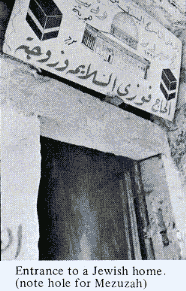 I do not intend to discuss the historic claims of Jews, or Israel,
to Jerusalem as its capital, nor do I want to go into the political
issues as to whether it's feasible to make Jerusalem once again
a divided or internationalized city. But I do want to discuss
one particular aspect of this problem.
I do not intend to discuss the historic claims of Jews, or Israel,
to Jerusalem as its capital, nor do I want to go into the political
issues as to whether it's feasible to make Jerusalem once again
a divided or internationalized city. But I do want to discuss
one particular aspect of this problem.
Many say to us Jews that, even in the best of days before the establishment of the State, Jews only lived in one section of the Old City, called the Jewish Quarter, and, since there are four quarters, and we have had only one, what claim do we have to sovereignty over the whole of the Old City? Unfortunately, I find that not only non-Jews, but even Jews seem to accept this apparently reasonable 'fact.' We Jews also speak of the "Jewish" Quarter. Even the Israeli government has laid down special regulations about the Jewish Quarter, regarding settlement of Jews, which do not equally apply to the other quarters. I see in this a false assumption, and a great danger if we accept such a way of thinking. For, in actuality, the entire Old City, all four quarters, has been inhabited by Jews for at least the last few centuries. And Jewish population has been, if not a majority, a substantial minority in these quarters, at various points in history.
The Divisions
Now, think of Jerusalem as a rectangle, crisscrossed by two streets that divide the city, into east, west, north and south. The first street runs from Damascus Gate to the Zion Gate and divides the city into east and west. The second street runs from Jaffa Gate - way down as you go to the Kotel (Western Wall). Don't turn right, however, as you would to go to the Kotel, but go on towards the Temple Mount, and that street divides the city into north and south. As a result, you get four quarters.
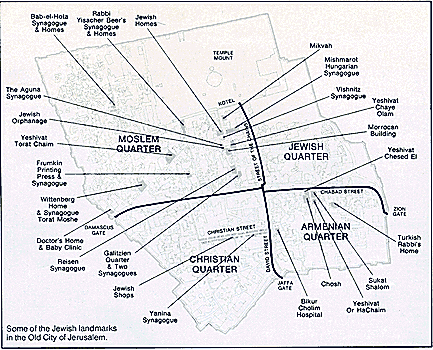
These four quarters are named after the communities that were
supposed to have occupied them exclusively. If we enter through
the Jaffa Gate and go down David Street there is the Christian
quarter on the left, and in that quarter, you have the Church
of the Sepulchre, the Tomb of Jesus, and the homes of the Patriarchs.
You have the Latin, i.e. the Catholic Patriarchs, and the Greek
Orthodox Patriarch, who is the head of the so-called 'Russian'
Church. And then as you continue down David Street, to your right,
you have the Armenian Quarter. When you get to the Jews Street
(from there to the left is the Moslem Quarter) you have the greater
part of the Temple area. And to the right is the fourth quarter,
which, we are told is called Jewish Quarter, with the obvious
implication that the others are not 'Jewish.' Incidentally, the
Jewish Quarter -everything to the right - is not strictly Jerusalem,
but is called Mount Zion. According to a number of books written
about two hundred years ago, there was a stone marking the boundary
between Zion, i.e. the so-called 'Jewish' Quarter and the so-called
'Moslem' Quarter, which was Jerusalem proper.
Map-makers and Labels
This arrangement of Jerusalem into four neighborhoods, named according to the ethnic affiliation of the people who lived there: Christian, Armenian, Moslem, Jewish, is a very artificial and arbitrary division of the city. These classifications are more for the convenience of map-makers than an actual ethnographic description. In the Armenian Quarter, for example, there is only one Armenian church, but there are four churches of other denominations: the Syrian Church, the Maronite Catholic, the Greek Orthodox of St. George, and the Anglican, just opposite the Tower of David. Besides that there is the Catholic welfare station and the Lutheran hostel. All this in the Armenian Quarter. So it is obvious to anyone who walks through the area that though called the Armenian Quarter, it does not mean that only Armenians live there.
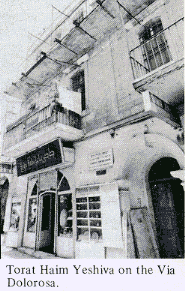 A similar situation prevails in the Moslem Quarter. If you go
there in December you'll see that it's really a good 'Christian'
quarter, because the greater part of the Via Dolorosa, a street
that has significance only for Christians, lies in the Moslem
Quarter, and it is lined on both sides with a great number of
Christian sites, such as the Church of St. Anne, the Convent of
the Sisters of Zion, Ecce Homo Church, the White Father Seminary,
Austrian Hospice, and a number of monasteries; to name only some
of the sites. So that just walking through these quarters you
see at once that their names, like many names, are misleading
if you accept them in the sense of being exclusive. This is apparent
to anyone who walks through the streets of Jerusalem. However,
what is unfortunately no longer so obvious is that in the three
'non-Jewish' quarters, there was an equally extensive Jewish settlement.
A similar situation prevails in the Moslem Quarter. If you go
there in December you'll see that it's really a good 'Christian'
quarter, because the greater part of the Via Dolorosa, a street
that has significance only for Christians, lies in the Moslem
Quarter, and it is lined on both sides with a great number of
Christian sites, such as the Church of St. Anne, the Convent of
the Sisters of Zion, Ecce Homo Church, the White Father Seminary,
Austrian Hospice, and a number of monasteries; to name only some
of the sites. So that just walking through these quarters you
see at once that their names, like many names, are misleading
if you accept them in the sense of being exclusive. This is apparent
to anyone who walks through the streets of Jerusalem. However,
what is unfortunately no longer so obvious is that in the three
'non-Jewish' quarters, there was an equally extensive Jewish settlement.
This fact is no longer obvious because, as may not be known, Jews
have been driven from those quarters, and the signs of their previous
settlement are no longer conspicuous. When I arrived in Jerusalem
on my first trip, in 1924, everything was still conspicuous, and
you could see the full extent of the settlement of the Jews in
the whole of the Old City. However, things began to change after
World War I, when the British arrived and took over. There were
outbreaks of Arab mob violence in 1920, 1929 and 1937 - and the
British said to the Jews, "Why do you live in far flung sections
of the city? Withdraw into the Jewish Quarter and we will be able
to protect you." When they got us into the Jewish Quarter,
they said: "You're living too close to the edge move inwards."
Finally they got us into a corner and annihilated the settlement.
The 'Armenian' Quarter
In the Armenian Quarter only one sector is actually occupied by the Armenian compound. The Armenian compound has a wall around it enclosing the big cathedral and its adjoining buildings. The rest of the quarter had to have a name. It wasn't Jewish, it wasn't Moslem, it wasn't Christian. So they applied to this section the name of its neighbor Armenian - simply a convenient fiction. Recently, an American Christian scholar made a study of the divisions of Jerusalem, and rightly calls this sector Hart el Yahud which means "The Jewish Section (of the Armenian Quarter)." Thus, here is an admission, from a non-Jew, that the 'Armenian Quarter' had a very heavy concentration of Jews.
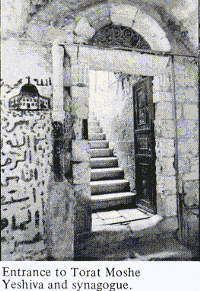 The Armenian Quarter, on the west, and the Jewish Quarter, on
the east, are divided by Chabad Street (Suq El Hussor Road). In
other words, one half of Chabad Street is Jewish, the other half
Armenian. Now, on one side of the Armenian Quarter there is, right
opposite the Chabad Synagogue, a very famous yeshiva of Kabbalists
called Yeshiva Hesed El, which was built in 1860 by a Jew
from Baghdad. He endowed the yeshiva with a famous library of
Kabbalistic works. Right next to Yeshiva Hesed El was the
center of the Ashkenazi settlement in the Jewish quarter: the
Hurva (Desolation) Synagogue, although the Hurva
was far from desolate. It had a yeshiva and two big synagogues
(the older one is still standing) and was a very busy center.
Before the Hurva Synagogue was built, a century
ago, the center of the Ashkenazi Jews was also in the Armenian
Quarter, in a compound called chatzer, i.e. a square
around which homes are built. It was called the Chatzer of
Rebbe Shayeh - Reb Shayeh Bardakee - also known by the name
of its synagogue, Sukat Shalom. Besides tens of dwellings,
and a mikva (ritual immersion pool) and this beautiful
synagogue, it was the seat of the Bet Din (Court) of Reb
Yosef Chaim Sonnenfeld. Built with money provided by the Jews
of Amsterdam in 1836, it was the center of the Ashkenazi Jewish
settlement until replaced by the Hurva.
The Armenian Quarter, on the west, and the Jewish Quarter, on
the east, are divided by Chabad Street (Suq El Hussor Road). In
other words, one half of Chabad Street is Jewish, the other half
Armenian. Now, on one side of the Armenian Quarter there is, right
opposite the Chabad Synagogue, a very famous yeshiva of Kabbalists
called Yeshiva Hesed El, which was built in 1860 by a Jew
from Baghdad. He endowed the yeshiva with a famous library of
Kabbalistic works. Right next to Yeshiva Hesed El was the
center of the Ashkenazi settlement in the Jewish quarter: the
Hurva (Desolation) Synagogue, although the Hurva
was far from desolate. It had a yeshiva and two big synagogues
(the older one is still standing) and was a very busy center.
Before the Hurva Synagogue was built, a century
ago, the center of the Ashkenazi Jews was also in the Armenian
Quarter, in a compound called chatzer, i.e. a square
around which homes are built. It was called the Chatzer of
Rebbe Shayeh - Reb Shayeh Bardakee - also known by the name
of its synagogue, Sukat Shalom. Besides tens of dwellings,
and a mikva (ritual immersion pool) and this beautiful
synagogue, it was the seat of the Bet Din (Court) of Reb
Yosef Chaim Sonnenfeld. Built with money provided by the Jews
of Amsterdam in 1836, it was the center of the Ashkenazi Jewish
settlement until replaced by the Hurva.
Another very interesting building in the Armenian Quarter, is adjacent to the St. George Church. It was purchased by a Turkish rabbi who, in 1604, wrote a will in which he describes this building which he was leaving to his children so you can see how long ago he bought it. He delineated the boundaries, and mentions the church as one of them. The building is still standing; it is being renovated now. Strange thing: in his will, the Rabbi warns his descendants not to let the building out of the family's possession. "I bought this building," he writes, "so that when Mashiach comes, and we have revival of the dead, I will have a home in Jerusalem. And so, I want the building to remain in our possession." It has not gone out of the possession of this family, even until now. Two hundred years ago there was family litigation about this particular property and one of the rabbis, in his official response, quotes this will as a proof of the family's ownership from that early date.
There is, also, in the Armenian Quarter a whole section belonging
to Jews called the chosh (in Arabic: a pen, an enclosure
for animals). It was bought by a Hungarian Jew, named Zadok Kraus.
The old-timers still call it Reb Zadok's Chosh. The story
goes that he bought it for a sack of rice. (Some say it was a
sack of potatoes, but they didn't have potatoes in those days
-- it was a luxury unknown to this part of the world so it must
have been rice which he offered the Arab owner.) Land didn't have
the great value it does now in Jerusalem, and a sack of rice was
a fair price then. In the chosh there are about thirty
Jewish homes and two synagogues still standing today.
The 'Christian' Quarter
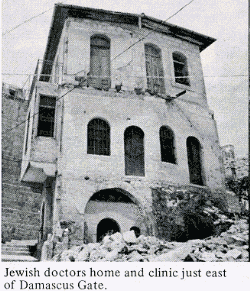 I remember Christian Street as a street of shops
many of which were Jewish. In 1875 a German, named
Gott, came here and wrote about Jerusalem. He describes it street
by street. When he comes to the Christian Street he says
that, 'unfortunately' all the shops on this street are owned by
Jews and it could just as well be called the Jews' Street.
I still remember a building on Christian Street
(if you want to take the trouble to locate it, it's No. 80 - there's
a parlor there now where you can have a tattoo done) where there
was a synagogue. About forty years ago, as I was going to the
Kotel on Shabbat, a man standing on the corner of
Christian Street asked me if I could be a tenth (to a minyan).
It was a synagogue of Yanina Jews - Yanina is a community
in the north of Greece and its Jews had two synagogues in Jerusalem,
one in the Ohel Moshe Quarter and this one in the Old City. Many
Greek Jews had their shops on Christian Street and, nearby, the
market called Aftimos was all Jewish. There also exists a copy
of a deed of transfer dated 1826 of one Jew transferring his property
in the Christian Quarter to another Jew. So you have an idea as
to how 'Christian' the Christian Quarter was.
I remember Christian Street as a street of shops
many of which were Jewish. In 1875 a German, named
Gott, came here and wrote about Jerusalem. He describes it street
by street. When he comes to the Christian Street he says
that, 'unfortunately' all the shops on this street are owned by
Jews and it could just as well be called the Jews' Street.
I still remember a building on Christian Street
(if you want to take the trouble to locate it, it's No. 80 - there's
a parlor there now where you can have a tattoo done) where there
was a synagogue. About forty years ago, as I was going to the
Kotel on Shabbat, a man standing on the corner of
Christian Street asked me if I could be a tenth (to a minyan).
It was a synagogue of Yanina Jews - Yanina is a community
in the north of Greece and its Jews had two synagogues in Jerusalem,
one in the Ohel Moshe Quarter and this one in the Old City. Many
Greek Jews had their shops on Christian Street and, nearby, the
market called Aftimos was all Jewish. There also exists a copy
of a deed of transfer dated 1826 of one Jew transferring his property
in the Christian Quarter to another Jew. So you have an idea as
to how 'Christian' the Christian Quarter was.
The 'Moslem' Quarter
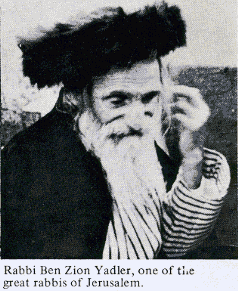 The Moslem Quarter is described in detail by one of the great
rabbis of Jerusalem, who died ten years ago, Ben-Zion Yadler.
Rabbi Yadler would go to the Kotel on Tisha B'av at
midnight, when he would begin teaching Midrash. Up till
twelve o'clock he wouldn't appear - there were too many 'Zionists'
who used to come. But at twelve we would all gather together
and he would tell us about Jerusalem. I remember once that Arabs
began throwing stones at us. He said to us in Yiddish, "Don't
be upset. You wanted them to give you back Palestine; they're
giving it to you stone by stone."
The Moslem Quarter is described in detail by one of the great
rabbis of Jerusalem, who died ten years ago, Ben-Zion Yadler.
Rabbi Yadler would go to the Kotel on Tisha B'av at
midnight, when he would begin teaching Midrash. Up till
twelve o'clock he wouldn't appear - there were too many 'Zionists'
who used to come. But at twelve we would all gather together
and he would tell us about Jerusalem. I remember once that Arabs
began throwing stones at us. He said to us in Yiddish, "Don't
be upset. You wanted them to give you back Palestine; they're
giving it to you stone by stone."
He writes a full description of what is today called the Moslem Quarter, and says as follows: Not only did the majority of Jews of Jerusalem live in the so-called 'Moslem' Quarter, but, also the more important Jews lived there, rather than in other sections of the city. And he goes on to describe twenty-two synagogues (I've been able to locate practically all of them), many mikvaot and yeshivot, among them, the biggest yeshiva in that part of the city - which is fortunately still standing - Torat Chaim. As you come from Damascus Gate, it's on the left side of El Wad Road. Very strange: it is right on the Via Dolorosa part of the street. (The Via Dolorosa curves at one point, and part of it is on El Wad Road.)
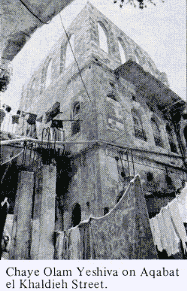 Then you have another big yeshiva, Chaye Olam, with a Talmud
Torah of twenty-two classrooms -- each classroom today is an Arab
home. (A Talmud Torah consists of eight grades, and here there
were three parallel classes.) Part of the building is now unused.
That part was never finished because the Arabs brought a case
against it in 1927 when the yeshiva wanted to start a new wing.
They weren't able to finish it, so they just have the walls up.
The yeshiva is close to what is the holiest part of Jerusalem
for Jews. Here is an entrance to the Temple area. It's called
Bab el-Katunin which means Gate of Cotton, because there were
cotton shops there. It's now being repaired by the Moslems. It
leads straight to the Mosque of Omar which is called by the Arabs
Sakra, meaning the 'Mosque covering the stone' which is
our Even Shtia the holiest spot for Jews in this world,
the ancient Holy of Holies, the stone upon which the Ark rested.
Then you have another big yeshiva, Chaye Olam, with a Talmud
Torah of twenty-two classrooms -- each classroom today is an Arab
home. (A Talmud Torah consists of eight grades, and here there
were three parallel classes.) Part of the building is now unused.
That part was never finished because the Arabs brought a case
against it in 1927 when the yeshiva wanted to start a new wing.
They weren't able to finish it, so they just have the walls up.
The yeshiva is close to what is the holiest part of Jerusalem
for Jews. Here is an entrance to the Temple area. It's called
Bab el-Katunin which means Gate of Cotton, because there were
cotton shops there. It's now being repaired by the Moslems. It
leads straight to the Mosque of Omar which is called by the Arabs
Sakra, meaning the 'Mosque covering the stone' which is
our Even Shtia the holiest spot for Jews in this world,
the ancient Holy of Holies, the stone upon which the Ark rested.
There is another building, very close to the golden-domed mosque,
which a Hungarian Jew, who arrived here about a hundred years
ago, put up. In that building were two yeshivot called Mishmarot
(Watches) because twenty-four hours a day Torah was studied
there. Rabbi Yadler described how at midnight one group would
come from the farthest corners of Jerusalem and another group
would go home at that late hour to a place called Bab-el-Hota,
close to the Lions Gate. I was still able to find one or two
Jews who lived there in their youth. A synagogue was there, but
it's been abandoned for over forty years. You can still see the
building near two Turkish baths. One is on the corner of the Bab-el-Katunin,
and is called Hamam-el-en; and closer to the Temple
Mount, very close, is the second bathhouse. Both of these bath-houses
had good mikvaot under the supervision of rabbis. The Arab
owners didn't want to lose Jewish trade, and they made special
arrangements for mikvaot.
Build First; Ask Later
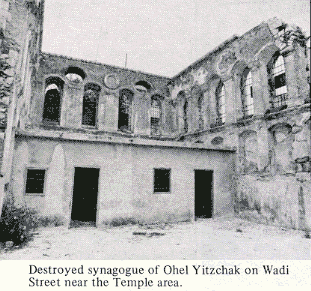 There was a very strange Turkish law in effect when this building
was erected. Usually in building, you first have a plan, you get
your plan approved by the government, and then you build. Well,
by Turkish Law, they build first and then they make a plan and
have it approved. But if you built not in accordance with
the regulations, there was a law: once built, it could not be
torn down. So you did a lot of building at night, under cover
of darkness, and then, in the morning, the inspector came around,
and even though the building wasn't according to regulations,
it could not be torn down. This particular building was close
to the Temple Mount and the Arabs objected to its being
put up, so it was completed in one night. Two walls were put up
at night, and because they were built with self-sacrifice, they
are still standing. The other two walls, no longer are.
There was a very strange Turkish law in effect when this building
was erected. Usually in building, you first have a plan, you get
your plan approved by the government, and then you build. Well,
by Turkish Law, they build first and then they make a plan and
have it approved. But if you built not in accordance with
the regulations, there was a law: once built, it could not be
torn down. So you did a lot of building at night, under cover
of darkness, and then, in the morning, the inspector came around,
and even though the building wasn't according to regulations,
it could not be torn down. This particular building was close
to the Temple Mount and the Arabs objected to its being
put up, so it was completed in one night. Two walls were put up
at night, and because they were built with self-sacrifice, they
are still standing. The other two walls, no longer are.
Lower East Side
So, you see, Jews lived not only in the 'Jewish' section. It's just as if someone would say today, "Jews in New York live only on the Lower East Side, not Brooklyn, not Bronx, not Queens - nowhere else." It's equally ridiculous for someone to say, "You lived only in the 'Jewish' section of Jerusalem." Jews lived in the Armenian section, in the Moslem section, and they had a synagogue and owned most of the shops in the Christian section.
Control
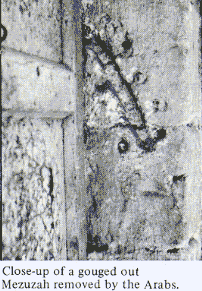 Once again, people are
reviving the issue of international control of Jerusalem. Even such an authority
as Dr. Kissinger has
said that Jerusalem is holy to the three religions. There is a
very great distinction. However, for the Christians and Moslems
there are holy places in Jerusalem. But the city, as a whole,
is not holy to them. However, to Jews the city itself is
holy. We have the regulations in the Mishna: "The
whole world is holy to Jews; Eretz Yisrael is holier, Jerusalem
is still holier, the Temple Mount is holiest." There is a
special sanctity that pervades Jerusalem as a city (irrespective
of whether there happens to be there synagogues or other holy
sites) which is not the same for Islam or Christianity.
Once again, people are
reviving the issue of international control of Jerusalem. Even such an authority
as Dr. Kissinger has
said that Jerusalem is holy to the three religions. There is a
very great distinction. However, for the Christians and Moslems
there are holy places in Jerusalem. But the city, as a whole,
is not holy to them. However, to Jews the city itself is
holy. We have the regulations in the Mishna: "The
whole world is holy to Jews; Eretz Yisrael is holier, Jerusalem
is still holier, the Temple Mount is holiest." There is a
special sanctity that pervades Jerusalem as a city (irrespective
of whether there happens to be there synagogues or other holy
sites) which is not the same for Islam or Christianity.
In the idea of international control, there also lies a great
danger. International cities do not work anywhere. It means bringing
the Soviet Union into the picture, controlling the holiness of
Jerusalem, and we know just how much holiness of religion means
to them. It is the thin edge of the wedge for them to get something
more than just control of the holy places. Holy places merit special
treatment consulates, for instance, are extra-territorial. In
the same way you might let Christians own their Sepulchre and
manage it as they please, but that doesn't mean that you
have to grant them control over the city ... In New York you have
St. Patrick's Cathedral but that does not give the Catholics control
over New York. Nor is New York, with all its sects, under international
control.
The 'Messiah' and the Pope
When Jerusalem was under the exclusive control of the Moslems for nineteen years, under Trans-Jordan, no one was worried about it. The Pope wasn't worried about it. King Hussein certainly wasn't worried about it. Only when Jews get control does the world get worried. It is interesting that there is no conflict between the different religions about any particular site. We have no interest in the Sepulchre, and Christians have no interest in the Hurva Synagogue. It is only in Hebron where we have a clash. The Tomb of the Patriarchs is sacred to Moslems and Jews. But Jerusalem is different even in the Wall the Arabs showed no real interest. Christianity, however, has a basic belief which to them is proof that Jesus really was 'Messiah': the fact that the Jews, because they never really accepted him, are in Galut (Exile) for 2000 years. They keep saying: "These people are the proof of the truth of Christianity. These people have been cursed and they'll never have their country back until they accept Jesus as the Messiah." All of a sudden the Jews get their country back and young Christian people come and say to their religious leaders: "What's happened to all your theories? Jews have got their country back." So they begin to get worried.
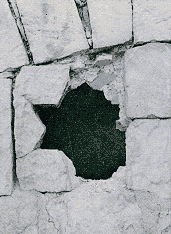 I happened to have been present at a discussion on a very high level on this matter between Chief Rabbi Herzog and the Pope.
This goes back to 1940 when I was Rabbi Herzog's private secretary.
Since he was an Irishman and I was an American we could both travel
in Europe; other nationals could not because war had been declared.
(I am ashamed to tell that I traveled with a passport that said
"missionary." We were scheduled to leave at six in the
morning. At about eleven the preceding night, the American Consul
informed me, "I'm sorry new regulations came out that you
can't travel without first being cleared by Washington. That'll
take a long time." I went over the regulations and noticed
that two groups could travel - one was missionaries - so I said,
"Mr. Consul, I'm covered, I'm going on a mission." So
he said to me, "If it's all right with you, it's all right
with me. But what will the Chief Rabbi say about it?" I said,
"I'll tell him when I get back." So my passport said
"missionary.")
I happened to have been present at a discussion on a very high level on this matter between Chief Rabbi Herzog and the Pope.
This goes back to 1940 when I was Rabbi Herzog's private secretary.
Since he was an Irishman and I was an American we could both travel
in Europe; other nationals could not because war had been declared.
(I am ashamed to tell that I traveled with a passport that said
"missionary." We were scheduled to leave at six in the
morning. At about eleven the preceding night, the American Consul
informed me, "I'm sorry new regulations came out that you
can't travel without first being cleared by Washington. That'll
take a long time." I went over the regulations and noticed
that two groups could travel - one was missionaries - so I said,
"Mr. Consul, I'm covered, I'm going on a mission." So
he said to me, "If it's all right with you, it's all right
with me. But what will the Chief Rabbi say about it?" I said,
"I'll tell him when I get back." So my passport said
"missionary.")
We came to Rome, and when the rabbi spoke with the Pope, the question
of the Jews returning to their land came up. The Chief Rabbi told
him that the Pope would gain much if he could show the hand of
Providence bringing back the Jews to their homeland after such
a long time the fulfillment of prophecy, etc. That would mean
more to Catholic youth than anything else. The Pope knew that
what he said was true. He also knew that Jews have bent over backwards
to show the Christian world that we take good care of their interests.
It could not be otherwise, as I have pointed out many times to
Christians. We have six million Jews in America and millions more
in other Christian countries. Are we going to antagonize the Christian
countries? For what? And yet, Christian public opinion is still
largely in favor of internationalizing Jerusalem.
The Prince of Peace
Oddly, the only people who fight over the Sepulchre are the Christians themselves. It's divided among a number of Christian sects - The Greek Orthodox, the Catholics, the Armenians and the Copts; they keep fighting over which group has rights to it. Sometimes they even fight over the right to clean part of the floor and these are terrific fights. To keep the peace, there always was an Arab (of a certain Arab family in the Old City -- it was hereditary) who held the key to the Sepulchre - he opened and closed the doors. A Turkish guard in Turkish days and in British days, a Moslem guard had to watch that the Christians did not fight among themselves. They used to tell a story about a family of Christians who came here from England and took their little daughter to see the sites, and she saw this guard who kept the peace at the Holy Sepulchre. She came home, and her minister asked her: "You saw everything in Jerusalem?" She said, "Oh yes." "And did you see the Holy Sepulchre?" "Oh yes, and not only that, but I saw the Prince of Peace!" "The Prince of Peace?" he asked. And she proceeded to describe this Arab guard who kept the peace ...
What Israel has done since 1967, is remove that Arab guard and hand the keys over to the Christians themselves. The Jews went to the Patriarchs of the Churches and said, "You decide among yourselves who is going to administer the Sepulchre Church." They were told they could go to the court, but should not fight. And today, they no longer have this disgrace of having their holy place under the jurisdiction of Moslems or Jews. So, Christians really should be quite happy with Jewish sovereignty in the Old City of Jerusalem.
Then again, some who speak of international control imply not just the Old City of Jerusalem, but include Bethlehem an area of about a hundred square miles. Now, that is putting up another little state. Our poor little. country is already divided. The Jews and the Moslems each want their little share and then, in addition, there would be an 'International' Christian state. That's laying the ground for lots of trouble, which I sincerely hope we all will be spared.
City of God
According to an old tale, when the Ohr HaChaim came to Jerusalem from Morocco, two hundred years ago, the Baal Shem Tov told his brother-in-law, Rabbi Gershon Kitover, to go and meet him. When Reb Gershon came, he found that the Ohr HaChaim had just passed away. Among a number of letters he wrote from Jerusalem, I found a remarkable one in which he says, "I came to Jerusalem, took a walk through the city and recalled the prayer 'I will always remember and be amazed when I see every city on its own hill, built, and the city of God is humbled to the depths.' Instead of '... the City of God,' the prayer should have read ' ... the city of Jerusalem is humbled.' But, the change of expression teaches us that even if we build up Jerusalem so that it's as beautiful as any other great city, it means nothing. When the 'City of God' will no longer be disgraced, then we will have reached what we want to reach."
And how do you rebuild the City of God? By rebuilding its synagogues and houses of Torah study.






